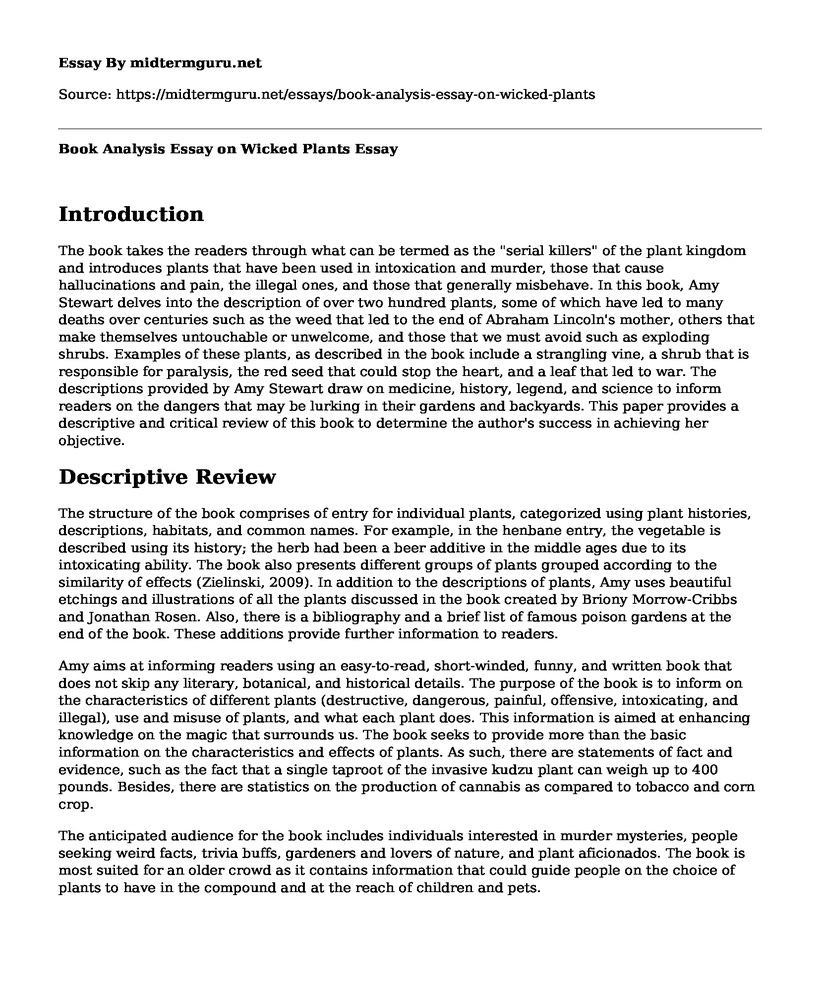Introduction
The book takes the readers through what can be termed as the "serial killers" of the plant kingdom and introduces plants that have been used in intoxication and murder, those that cause hallucinations and pain, the illegal ones, and those that generally misbehave. In this book, Amy Stewart delves into the description of over two hundred plants, some of which have led to many deaths over centuries such as the weed that led to the end of Abraham Lincoln's mother, others that make themselves untouchable or unwelcome, and those that we must avoid such as exploding shrubs. Examples of these plants, as described in the book include a strangling vine, a shrub that is responsible for paralysis, the red seed that could stop the heart, and a leaf that led to war. The descriptions provided by Amy Stewart draw on medicine, history, legend, and science to inform readers on the dangers that may be lurking in their gardens and backyards. This paper provides a descriptive and critical review of this book to determine the author's success in achieving her objective.
Descriptive Review
The structure of the book comprises of entry for individual plants, categorized using plant histories, descriptions, habitats, and common names. For example, in the henbane entry, the vegetable is described using its history; the herb had been a beer additive in the middle ages due to its intoxicating ability. The book also presents different groups of plants grouped according to the similarity of effects (Zielinski, 2009). In addition to the descriptions of plants, Amy uses beautiful etchings and illustrations of all the plants discussed in the book created by Briony Morrow-Cribbs and Jonathan Rosen. Also, there is a bibliography and a brief list of famous poison gardens at the end of the book. These additions provide further information to readers.
Amy aims at informing readers using an easy-to-read, short-winded, funny, and written book that does not skip any literary, botanical, and historical details. The purpose of the book is to inform on the characteristics of different plants (destructive, dangerous, painful, offensive, intoxicating, and illegal), use and misuse of plants, and what each plant does. This information is aimed at enhancing knowledge on the magic that surrounds us. The book seeks to provide more than the basic information on the characteristics and effects of plants. As such, there are statements of fact and evidence, such as the fact that a single taproot of the invasive kudzu plant can weigh up to 400 pounds. Besides, there are statistics on the production of cannabis as compared to tobacco and corn crop.
The anticipated audience for the book includes individuals interested in murder mysteries, people seeking weird facts, trivia buffs, gardeners and lovers of nature, and plant aficionados. The book is most suited for an older crowd as it contains information that could guide people on the choice of plants to have in the compound and at the reach of children and pets.
Critical Review
The aim of the book is not to be a detailed field guide or manual for poisonous plants. As Stewart notes, her main objective of the book is to alarm, entertain, and enlighten. This purpose is in order because she is just a gardener and a writer, and not a botanist. She further cautions readers not to over-rely on the book for diagnoses in the case of plant attacks, but to seek the help of a medical professional. By doing this, she makes it clear that her book is intended to provide information with a dose of fun and not to replace professional advice on handling plants. Stewart achieves her purpose with this book as it is informative and also portrays certain plants as "superstar" evil plants and some plant families as botanical criminals, which is fun to read.
The book makes relevant contributions to the field of biology as it provides classifications of plants depending on their effects. Also, there are relevant facts on the impact of these plants on human beings with examples of annual morbidities and mortalities. The book prompts further research as the examination of the effects of the plants on the human body is rudimentary, thus requiring further detail. Also, since she is not a biologist, she misses parts of the information and connections between the plants and insects. She also presents the plants that are of interest to her, which means that there is a need for further research to generate a more comprehensive list. The writing style is clear and involves creative personification of plants, description, illustrations, and a bit of sensationalism in the title. However, compared to the Drunken Botanist, this book is less informative. The book lacks an index, which reduces its usefulness to some extent.
Therefore, Wicked Plants is a good read for individuals seeking some knowledge of toxic plants, their characteristics, and effects. The book's aim purpose is to inform humorously, an objective that Stewart achieves. The book could, however, use more detailed descriptions of the effects of plants on the human body to make it more appealing to readers who are interested in plants.
Work Cited
Zielinski, Sarah. Wicked Plants (and Fungi). 2009, https://www.smithsonianmag.com/science-nature/wicked-plants-and-fungi-11681240/
Cite this page
Book Analysis Essay on Wicked Plants. (2023, Jan 26). Retrieved from https://midtermguru.com/essays/book-analysis-essay-on-wicked-plants
If you are the original author of this essay and no longer wish to have it published on the midtermguru.com website, please click below to request its removal:
- Philosophers Main View about Consciousness, The Self, and Personal Identity
- The Importance of Turkey in Energy Hubs and Renewable Energy
- Essay on John Winthrops Puritan and Waldo Emerson Transcendentalism
- Paper Example on Microbiology
- Law Enforcement Agencies Evolve to Combat Crime in Changing Society - Research Paper
- Be Prepared for Floods: Create a Flood Safety Plan - Essay Sample
- Canada: Protecting the Environment in an Industrialized Nation - Research Paper







